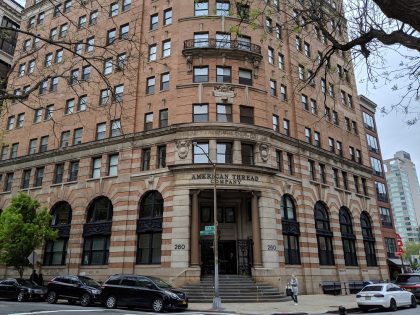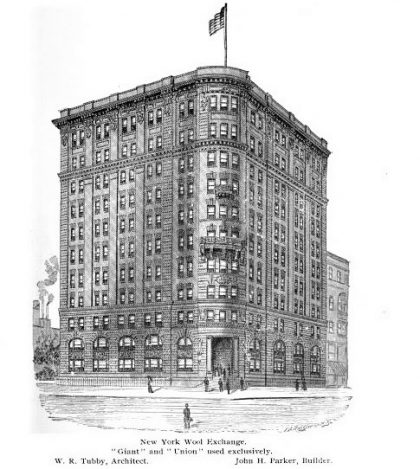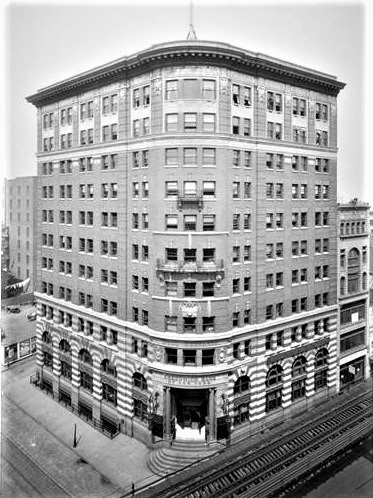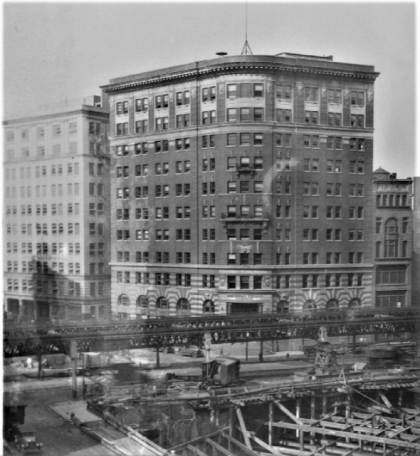The History of 260 West Broadway – The Wool Exchange or American Thread building
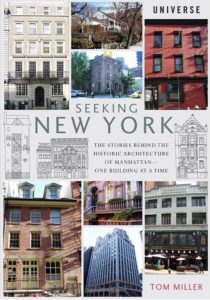 Tom Miller, who writes about the history of Manhattan buildings at Daytonian in Manhattan, has allowed Tribeca Citizen to create a database of his Tribeca posts. If you enjoy these, and you will, then you should definitely check out his website, which also has write-ups about buildings all over the island. And don’t miss his book, Seeking New York: The Stories Behind the Historic Architecture of Manhattan—One Building at a Time.
Tom Miller, who writes about the history of Manhattan buildings at Daytonian in Manhattan, has allowed Tribeca Citizen to create a database of his Tribeca posts. If you enjoy these, and you will, then you should definitely check out his website, which also has write-ups about buildings all over the island. And don’t miss his book, Seeking New York: The Stories Behind the Historic Architecture of Manhattan—One Building at a Time.
··································
The Tariff Act of 1890 promised to significantly affect the importation of wool and wool products from Europe. The changes would affect Manhattan wool brokers and merchants. In consequence, Allan Macnaughtan rallied them to form a Wool Exchange. The Evening World explained, “As imports will be large under the wool clause of the Tariff bill it is proposed to transact business by sample at the exchange.” The concept was heartily embraced and the Wool Exchange was formed.
Macnaughtan, however, had additional motives. While the founding of the Wool Exchange was a solid and laudable move; Allan Macnaughtan saw personal opportunities in it. Backing the construction of a headquarters structure was the Tradesmen’s National Bank, the president of which, not coincidentally, was Macnaughtan’s brother, Allan. More importantly, together they formed the Wool Warehouse Company, intended to store the goods of the Wool Exchange members within the Exchange building, for a price.
The property for the Wool Exchange building was initially purchased by the Wool Warehouse Company, using advances from the Tradesmen’s National Bank endorsed by Allan Macnaughtan. On April 1, 1893 three four-story brick buildings were purchased on West Broadway; and the site was completed in February the following year with a three-story wooden store on West Broadway and a three-story brick building on St. John’s Lane. The site sat on the curve where Beach Street morphed into West Broadway.
Architect William Bunker Tubby filed plans on July 1894 for an 11-story brick structure to cost $275,000. That amount would quickly rise. The following month, on August 22, The Evening World announced “New Wool Exchange Building” and reported “The wool dealers of the city are anxious to get into their new exchange building, which is in course of erection at 144 and 150 West Broadway and which is to cost $500,000.” That would be more than $15 million today. (West Broadway was renumbered in 1897, giving it the building the address of 260.)
Completed late in 1895, William Tubby’s reserved Renaissance Revival design drew praise nationwide. The Engineering Magazine called it “a strong, plain design, admirably in keeping with the character of the structure.” And the New-York Daily Tribune said “The building itself is a triumph of architectural art.”
Tubby had gently contoured the facade along the Beach Street-West Broadway curve. The three-story base featured alternating stone and brick bands which became bold voussoirs above the arched openings–feeling more Moorish than Renaissance. But the entrance stole the show at this level. The architect took full advantage of the corner site to create drama. The entrance sat deep within a two-story vestibule. From below its polished granite columns a staircase cascaded to the sidewalk.
Building Age explained that the building included “an immense storage warehouse for wool, a bank that will be primarily connected with wool and woolen interests, the Wool Exchange, a members’ club and a large number of offices…The Wool Exchange and the bank will occupy the first floor, while the club will use the top floor, which has an area of 12,000 square feet.” That bank, of course, was the Trademen’s National Bank.
The Wool Club had been formed in 1894, soon after the organization of the Wool Exchange. Its purpose was “to promote social intercourse between men engaged in the wool business and to centralize the trade in this city.” (Boston was the center of the wool trade at the time.) Its president was none other than the Mayor of New York, William L. Strong. On January 5, 1896 The Sun reported on the club’s opening. “Nearly 400 merchants, prominent in the wool and dry goods trade, visited the club while the reception was going on.”
At the time of the opening there were 300 members, who enjoyed luxurious surroundings. “The club rooms are divided into a large dining room, finished in ivory white and red, two private dining rooms, and a ladies’ dining room.”
The Sun chimed in, saying that the club’s office was paneled in black walnut and “At one end is an immense open fireplace, and in the centre are files and a richly carved reading table. The windows are of stained glass, and each is a reproduction of an old English book mark.” There was a women’s reception room and women’s dining room, both of which were “richly frescoed and carpeted with rugs.”
The Wool Club’s cafe was 30 feet across and its domed ceiling 19 feet high. The Sun remarked “The culinary and other arrangements of the club are excellent.”
From the beginning several of the tenants in the Wool Exchange Building were a bit shady. Not the least of which was William E. Valentine whose Standard Coal and Oil Company offices were here.
On November 12, 1896 The Sun reported that he had appeared in court to answer to two charges, “one of forgery in the second degree and the other of assaulting and abducting May Wintage.” While that was playing out, the vendors who had carpeted and furnished his office had not been paid. The article added that Deputy Sheriff Butler had seized the “desks and office furniture” as well as the carpets.
The next day the newspaper reported on two more arrests, Mr. and Mrs. C. R. McLaughlin. Detectives told reporters they “are connected with the Valentine gang of swindlers.” McLaughlin, whose real name was Charles Waldring, was the manager of the Standard Coal and Wood Company. And Mrs. McLaughlin was in fact Daisy Hampton, and not his wife. The pair had been on the run for more than a year for purchasing expensive items and paying for them with phony checks.
William Newburg’s brokerage office was in the building at the same time. He, too, found himself behind bars that year. He and an acquaintance, Walter Holinghausen, borrowed $1,000 from a money lender, Joseph H. Roberts. It was a considerable sum, equaling nearly $31,000 today. Holinghausen purported to be a liquor dealer, and as security the men gave Roberts a warehouse receipt for eight barrels of whiskey. But the barrels were filled with water.
The pair apparently had assumed Roberts would not be poking into the barrels. They were arrested on November 13, 1896. And it appeared this was not the only time they pulled the scam. The Sun reported “complaints involving $5,000 may be formulated.”
By now Allan Macnaughton was president of the Wool Exchange. In February 1897 his bank transferred title to the property to the Wool Exchange, including the $600,000 outstanding mortgage which apparently covered the cost of the site as well.
A long term tenant would be the Master Steam and Hot Water Fitters’ Association, which initially took space on the ninth floor in 1897. Its offices would be the scene of union negotiations for years. Among the first, in April that year, centered around the 25 cent raise the workers demanded. Steamfitters earned $3.50 a day at the time and their helpers $2.
While the Wool Exchange was doing well, the Macnaughtan brothers were not. Their scheme relied almost solely on the success of the Wool Warehouse Company, but it failed in 1898. That resulted in the failure of the Tradesmen’s National Bank. The brothers each filed for personal bankruptcy in November 1898.
In reporting on the developments The United States Investor, on November 19, was brutal. It called the brothers’ reputations “certainly not the creme de la creme of straightforward and reliable business men” and that “no one in the wool trade of financial circles had a good word to say for them.”
Things did not look good for the brothers. On October 7 The New York Times had reported that the bank examiner had made “the unequivocal statement that the Macnaughtans were responsible for the closing of the bank.”
Both men appeared in a downtown office on January 12, 1899 to be questioned about the failure of the Tradesmen’s National Bank. When the procedures were adjourned for lunch at noon, United States marshals moved in and arrested the brothers. The Times said it “was unexpected by the Macnaughtan brothers and some others in the room [and] it created a considerable sensation.” They were charged with bank fraud.
In the meantime, things went on essentially as normal in the Wool Exchange Building. In 1898 three floors were leased to the American Thread Company; and the banking level became home to the newly-formed National Securities Bank in June 1900.
At the time The Merchants’ Safe Deposit Company occupied the basement. On March 11 that year the New-York Daily Tribune noted as well, “Other tenants of the building are wool merchants, wool brokers, wholesale drygoods dealers, wholesale glass firms, lace houses, wholesale grocers and other kindred trades.”
In April 1901 the Real Estate Record & Builders’ Guide announced that the American Thread Company had purchased the Wool Exchange Building for $700,000 (about $21.3 million today). The New York Times reminded readers that the American Thread Company currently occupied three floors and that “The Wool Club has elaborately fitted up rooms on one of the upper floors, and part of the street floor is occupied as a Post Office sub-station.”
Despite the change in ownership, the Wool Exchange remained in its headquarters and the building would be referred to as the Wool Exchange Building for years to come. Among the new tenants in 1903 was the New-England National Automatic Fire Alarm Company.
On August 25, 1903 the building next door at No. 268 West Broadway caught fire. It was occupied primarily by whiskey distillers P. W. Engs & Son, resulting in a massive blaze and explosions. Firefighters took advantage of the Wool Exchange Building’s height (four stories higher than No. 268) and its advanced engineering. The New-York Tribune reported “The firemen entered the Wool Exchange Building and, attaching hose to the standpipes which are on every floor, fought the flames from these vantage points.”
On the third floor of No. 260 in 1905 was the office of “Wintersmith, Broker,” as stenciled on the glass of the door. Police were not so certain that it was truly stocks being traded inside. On May 30 The Sun reported that “Captain Eggers made an ax raid yesterday afternoon on an alleged poolroom and poolroom telephone exchange.” (A “poolroom” was an illegal horse betting operation.)
“Eggers and his men smashed in the door and found ten men huddled together. One of the men attempted to conceal some racing sheets inside his trousers and objected to being searched. He resisted stoutly until Eggers landed a short hook on the end of his nose, when he gave up both the papers and some blood.”
The ten men were herded out of the office, and 25 telephones and a switchboard were seized. Eggers told reporters that by ripping out the switchboard he had probably taken 20 other poolrooms out of business.
In an unexpected twist, on August 5 the Greenpoint Weekly Star reported that the principal of Wintersmith & Co., Lawrence Stevens, had filed a $5,000 suit against Police Commissioner McAdoo and Captain Eggart, “charging them with illegally raiding his place of business.” Stevens complained that the police “without warrant but with much force took possession of his premises, ripped out and carried away his telephone and much of the material for the conduct of his business.”
Joining the tenant list were the newly-formed Fitch Manufacturing Company, “makers of eiderdowns,” the National Dress Goods Co., here by 1907; and at around the same time the American Window Glass Company moved in.
In 1917, after being in the building for a quarter of a century, the Steam and Hot Water Fitters’ Association moved to new quarters. Taking advantage of the patriotism sparked by World War I was the U. S. Army & Navy Tablet Co., which moved in that year. Despite the implications of its name, the firm had nothing to do with the United States military. Its advertisements promised “One or two doses will make you feel ten years younger. Best known remedy for Constipation, Sour Stomach and Dyspepsia.”
The Grosser Knitting Machine Co. was leasing space by then, as was the Hubbard Oven Company. The Wool Exchange was still here, as was the Wool Club. Its rooms were annually used the by New York and New Jersey Cricket Association for its yearly meetings.
The American Thread Company operated a sizable plant in Willimantic, Connecticut. As was common with large factories the firm supplied company houses to its workers at discounted rents.
The hundreds of factory employees were shocked in January 1925 when American Thread made an across-the-board wage cut. The union ordered a strike. On April 11, 1925 management representatives walked out of an arbitration meeting. Speaking for the Board of Directors, Don H. Curtis said it “could not consider restoration of the wage cut or any part of it.” The firm’s stubborn stance resulted little-by-little in desperate workers returning to work. By the beginning of summer 700 had returned and American Thread Company had lost patience with the 35 holdouts.
On July 16 The New York Times reported “Eviction of tenants of houses belonging to the American Thread Company who were former employees and are now among the strikers was carried out today.” The court had given notice on June 10 and now deputy sheriffs arrived to “put out” those who remained.
The Wool Club was still here on March 3, 1941 when it received its liquor license “for on premises consumption.” At the time chemical dealers Whittaker, Clark & Daniels, Inc. had been here a decade and would remain at least through 1955. The 1940’s also saw the headquarters of the AFL Union and the American Drug Company in the building.
In 1965 American Thread Company moved to No. 90 Park Avenue. It was a marked change for the former Wool Exchange Building. Department of Buildings records listed a paint store in the former bank space, a lamp showroom on the second floor, and “third and fourth to be kept vacant.”
Other tenants included the KikkoMan soy sauce company; Albert Products, Inc., distributors of Wool-Soft fabric cleaner; and by 1970 the offices of the Archaeological Institute of America.
The Institute published the American Journal of Archaeology and Archaeology, A Magazine Dealing with the Antiquity of the World here. The group also sponsored exotic tours. In the spring of 1971 it offered a 32-day tour of cave paintings in France and Spring, and in April 1974 a three-week visit to Iran and Afghanistan.
It and the other tenants would have to find new homes soon. On August 25, 1977 Laurie Johnston, writing in The New York Times remarked that the neighborhood was taking on a Soho-like personality. Advising that “Tribeca” was “the unofficial name for the Triangle Below Canal Street (pronounced Try-beeka by logic, Try-becka by custom),” and mentioning high-profile figures in the arts who had recently moved in, she added that the American Thread Building was “among other major Tribeca Buildings being prepared for conversion” to residential.
The renovation, which was completed in 1981, prompted The Times’ Paul Goldberger to call the project “probably TriBeCa’s finest and most luxurious condominium conversion so far. It is a more elegant building that many of its neighbors, graciously rounding the curve of the street as West Broadway meets Beach Street.”
An advertisement in Christopher Magazine in 1982 touted “There is nothing standard about 260 West Broadway.” Indeed, several of the apartments were duplexes.
The upscale building received disturbing press in July 1993. In 1987 Louis Santos had been hired as a custodian. Well liked by the residents, he arrived for work as usual at 7:00 on the morning of July 17, 1993 but never reported in. At 9:20 sanitation workers pulled up to the loading dock at the rear of the building, where they found the 50-year-old’s body, with two bullet wounds to the head. His empty wallet was on the ground next to him.
The loss of the cornice is highly regrettable. But overall William B. Tubby’s “triumph of architectural art” is greatly intact.







